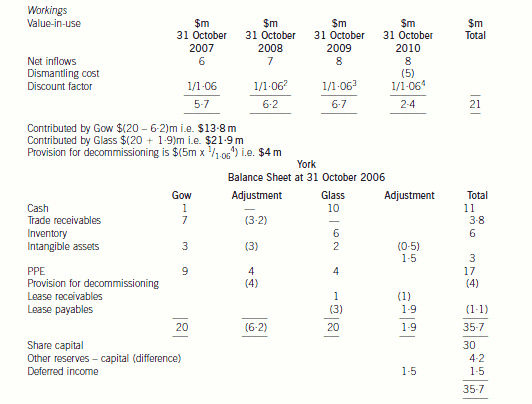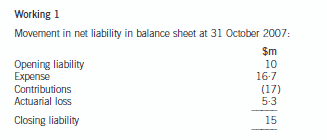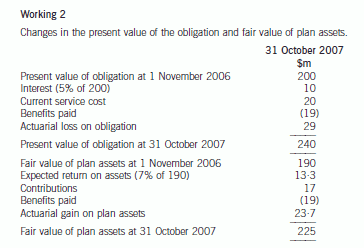速看!掌握正确的ACCA考试备考方法可以让你事半功倍!
发布时间:2020-04-08
在ACCA考试的漫长道路里,很多同学都是因为有了良好的学习方法,才快速通过了ACCA的考试,掌握正确的ACCA考试备考方法可以让你事半功倍哦,下面就来看看51题库考试学习网为大家分享的ACCA考试备考的方法吧。
01、填写信息,稳定情绪
试卷发下来后,立即忙于答题是不科学的,应先填写信息,写清姓名和准考证号等,这样做不仅是考试的要求,更是一剂稳定情绪的“良药”。
02、总揽全卷,区别难易
打开试卷,看看哪些是基础题,哪些是中档题,哪些是难题或压轴题,按先易后难的原则,确定解题顺序,逐题进行解答。
力争做到“巧做低档题,题题全做对;稳做中档题,一分不浪费;尽力冲击高分题,做错也无悔。”
03、认真审题,灵活答题
审题要做到一不漏掉题,二不看错题,三要审准题,四要看全题目的条件和结论。
审题中还要灵活运用知识,发现和寻找简捷的解题方法。
04、过程清晰,稳中求快
一要书写清晰,速度略快;
二要一次成功;
三要提高答题速度;
四要科学使用草稿纸;
五要力求准确,防止欲速不达。
05、心理状态,注意调节
考试中,要克服满不在乎的自负心理,要抛弃“胜败在此一举”的负重心理,要克服畏首畏尾的胆怯心理。面对难、中、易的试卷,调节好心理,积极应对。
06、尽量多做,分分必争
ACCA考试评分,多按步骤、按知识点给分、按要点给分毕竟ACCA考试费用不低。
因此,考生在答题时,就要会多少,答多少,哪怕是一条辅助线,一个符号,一小段文字,都可写上,没有把握也要敢于写,千万不要将不能完全做出或答案算不出的题放弃不做。
07、抓住“题眼”,构建“桥梁”
一般难题都有个关键点(称之为“题眼”),抓住了“题眼”,问题就易于解决了。
此外,还要利用相关的知识、规律、信息进行多方联系,构建“桥梁”,找出问题的内在联系,从而构思解题方案,准确、快捷地解决问题。
好的,今天就为大家分享到这里,小伙伴们备考是一条艰辛而又漫长的路,所以要每天坚持学习,日积月累,你才会比别人更有机会通过考试。所以加油吧备考的小伙伴们,付出总会有收获的。
下面小编为大家准备了 ACCA考试 的相关考题,供大家学习参考。
(b) Prepare the balance sheet of York at 31 October 2006, using International Financial Reporting Standards,
discussing the nature of the accounting treatments selected, the adjustments made and the values placed
on the items in the balance sheet. (20 marks)

Gow’s net assets
IAS36 ‘Impairment of Assets’, sets out the events that might indicate that an asset is impaired. These circumstances include
external events such as the decline in the market value of an asset and internal events such as a reduction in the cash flows
to be generated from an asset or cash generating unit. The loss of the only customer of a cash generating unit (power station)
would be an indication of the possible impairment of the cash generating unit. Therefore, the power station will have to be
impairment tested.
The recoverable amount will have to be determined and compared to the value given to the asset on the setting up of the
joint venture. The recoverable amount is the higher of the cash generating unit’s fair value less costs to sell, and its value-inuse.
The fair value less costs to sell will be $15 million which is the offer for the purchase of the power station ($16 million)
less the costs to sell ($1 million). The value-in-use is the discounted value of the future cash flows expected to arise from the
cash generating unit. The future dismantling costs should be provided for as it has been agreed with the government that it
will be dismantled. The cost should be included in the future cash flows for the purpose of calculating value-in-use and
provided for in the financial statements and the cost added to the property, plant and equipment ($4 million ($5m/1·064)).
The value-in-use based on a discount rate of 6 per cent is $21 million (working). Therefore, the recoverable amount is
$21 million which is higher than the carrying value of the cash generating unit ($20 million) and, therefore, the value of the
cash generating unit is not impaired when compared to the present carrying value of $20 million (value before impairment
test).
Additionally IAS39, ‘Financial Instruments: recognition and measurement’, says that an entity must assess at each balance
sheet date whether a financial asset is impaired. In this case the receivable of $7 million is likely to be impaired as Race is
going into administration. The present value of the estimated future cash flows will be calculated. Normally cash receipts from
trade receivables will not be discounted but because the amounts are not likely to be received for a year then the anticipated
cash payment is 80% of ($5 million × 1/1·06), i.e. $3·8 million. Thus a provision for the impairment of the trade receivables
of $3·2 million should be made. The intangible asset of $3 million would be valueless as the contract has been terminated.
Glass’s Net Assets
The leased property continues to be accounted for as property, plant and equipment and the carrying amount will not be
adjusted. However, the remaining useful life of the property will be revised to reflect the shorter term. Thus the property will
be depreciated at $2 million per annum over the next two years. The change to the depreciation period is applied prospectively
not retrospectively. The lease liability must be assessed under IAS39 in order to determine whether it constitutes a
de-recognition of a financial liability. As the change is a modification of the lease and not an extinguishment, the lease liability
would not be derecognised. The lease liability will be adjusted for the one off payment of $1 million and re-measured to the
present value of the revised future cash flows. That is $0·6 million/1·07 + $0·6 million/(1·07 × 1·07) i.e. $1·1 million. The
adjustment to the lease liability would normally be recognised in profit or loss but in this case it will affect the net capital
contributed by Glass.
The termination cost of the contract cannot be treated as an intangible asset. It is similar to redundancy costs paid to terminate
a contract of employment. It represents compensation for the loss of future income for the agency. Therefore it must be
removed from the balance sheet of York. The recognition criteria for an intangible asset require that there should be probable
future economic benefits flowing to York and the cost can be measured reliably. The latter criterion is met but the first criterion
is not. The cost of gaining future customers is not linked to this compensation.
IAS18 ‘Revenue’ contains a concept of a ‘multiple element’ arrangement. This is a contract which contains two or more
elements which are in substance separate and are separately identifiable. In other words, the two elements can operate
independently from each other. In this case, the contract with the overseas company has two distinct elements. There is a
contract not to supply gas to any other customer in the country and there is a contract to sell gas at fair value to the overseas
company. The contract has not been fulfilled as yet and therefore the payment of $1·5 million should not be taken to profit
or loss in its entirety at the first opportunity. The non supply of gas to customers in that country occurs over the four year
period of the contract and therefore the payment should be recognised over that period. Therefore the amount should be
shown as deferred income and not as a deduction from intangible assets. The revenue on the sale of gas will be recognised
as normal according to IAS18.
There may be an issue over the value of the net assets being contributed. The net assets contributed by Glass amount to
$21·9 million whereas those contributed by Gow only total $13·8 million after taking into account any adjustments required
by IFRS. The joint venturers have equal shareholding in York but no formal written agreements, thus problems may arise ifGlass feels that the contributions to the joint venture are unequal.

2 Which of the following are correct?
1. The balance sheet value of inventory should be as close as possible to net realisable value.
2. The valuation of finished goods inventory must include production overheads.
3. Production overheads included in valuing inventory should be calculated by reference to the company’s normal
level of production during the period.
4. In assessing net realisable value, inventory items must be considered separately, or in groups of similar items,
not by taking the inventory value as a whole.
A 1 and 2 only
B 3 and 4 only
C 1 and 3 only
D 2, 3 and 4
(b) (i) Discusses the principles involved in accounting for claims made under the above warranty provision.
(6 marks)
(ii) Shows the accounting treatment for the above warranty provision under IAS37 ‘Provisions, Contingent
Liabilities and Contingent Assets’ for the year ended 31 October 2007. (3 marks)
Appropriateness of the format and presentation of the report and communication of advice. (2 marks)
(b) Provisions – IAS37
An entity must recognise a provision under IAS37 if, and only if:
(a) a present obligation (legal or constructive) has arisen as a result of a past event (the obligating event)
(b) it is probable (‘more likely than not’), that an outflow of resources embodying economic benefits will be required to settle
the obligation
(c) the amount can be estimated reliably
An obligating event is an event that creates a legal or constructive obligation and, therefore, results in an enterprise having
no realistic alternative but to settle the obligation. A constructive obligation arises if past practice creates a valid expectation
on the part of a third party. If it is more likely than not that no present obligation exists, the enterprise should disclose a
contingent liability, unless the possibility of an outflow of resources is remote.
The amount recognised as a provision should be the best estimate of the expenditure required to settle the present obligation
at the balance sheet date, that is, the amount that an enterprise would rationally pay to settle the obligation at the balance
sheet date or to transfer it to a third party. This means provisions for large populations of events such as warranties, are
measured at a probability weighted expected value. In reaching its best estimate, the entity should take into account the risks
and uncertainties that surround the underlying events.
Expected cash outflows should be discounted to their present values, where the effect of the time value of money is material
using a risk adjusted rate (it should not reflect risks for which future cash flows have been adjusted). If some or all of the
expenditure required to settle a provision is expected to be reimbursed by another party, the reimbursement should be
recognised as a separate asset when, and only when, it is virtually certain that reimbursement will be received if the entity
settles the obligation. The amount recognised should not exceed the amount of the provision. In measuring a provision future
events should be considered. The provision for the warranty claim will be determined by using the expected value method.
The past event which causes the obligation is the initial sale of the product with the warranty given at that time. It would be
appropriate for the company to make a provision for the Year 1 warranty of $280,000 and Year 2 warranty of $350,000,
which represents the best estimate of the obligation (see Appendix 2). Only if the insurance company have validated the
counter claim will Macaljoy be able to recognise the asset and income. Recovery has to be virtually certain. If it is virtually
certain, then Macaljoy may be able to recognise the asset. Generally contingent assets are never recognised, but disclosed
where an inflow of economic benefits is probable.
The company could discount the provision if it was considered that the time value of money was material. The majority of
provisions will reverse in the short term (within two years) and, therefore, the effects of discounting are likely to be immaterial.
In this case, using the risk adjusted rate (IAS37), the provision would be reduced to $269,000 in Year 1 and $323,000 in
Year 2. The company will have to determine whether this is material.
Appendix 1
The accounting for the defined benefit plan is as follows:



3 Mary Hobbes joined the board of Rosh and Company, a large retailer, as finance director earlier this year. Whilst she
was glad to have finally been given the chance to become finance director after several years as a financial
accountant, she also quickly realised that the new appointment would offer her a lot of challenges. In the first board
meeting, she realised that not only was she the only woman but she was also the youngest by many years.
Rosh was established almost 100 years ago. Members of the Rosh family have occupied senior board positions since
the outset and even after the company’s flotation 20 years ago a member of the Rosh family has either been executive
chairman or chief executive. The current longstanding chairman, Timothy Rosh, has already prepared his slightly
younger brother, Geoffrey (also a longstanding member of the board) to succeed him in two years’ time when he plans
to retire. The Rosh family, who still own 40% of the shares, consider it their right to occupy the most senior positions
in the company so have never been very active in external recruitment. They only appointed Mary because they felt
they needed a qualified accountant on the board to deal with changes in international financial reporting standards.
Several former executive members have been recruited as non-executives immediately after they retired from full-time
service. A recent death, however, has reduced the number of non-executive directors to two. These sit alongside an
executive board of seven that, apart from Mary, have all been in post for over ten years.
Mary noted that board meetings very rarely contain any significant discussion of strategy and never involve any debate
or disagreement. When she asked why this was, she was told that the directors had all known each other for so long
that they knew how each other thought. All of the other directors came from similar backgrounds, she was told, and
had worked for the company for so long that they all knew what was ‘best’ for the company in any given situation.
Mary observed that notes on strategy were not presented at board meetings and she asked Timothy Rosh whether the
existing board was fully equipped to formulate strategy in the changing world of retailing. She did not receive a reply.
Required:
(a) Explain ‘agency’ in the context of corporate governance and criticise the governance arrangements of Rosh
and Company. (12 marks)
(a) Defining and explaining agency
Agency is defined in relation to a principal. A principal appoints an agent to act on his or her behalf. In the case of corporate
governance, the principal is a shareholder in a joint stock company and the agents (that have an agency relationship with
principals) are the directors. The directors remain accountable to the principals for the stewardship of their investment in the
company. In the case of Rosh, 60% of the shares are owned by shareholders external to the Rosh family and the board has
agency responsibility to those shareholders.
Criticisms of Rosh’s CG arrangements
The corporate governance arrangements at Rosh and Company are far from ideal. Five points can be made based on the
evidence in the case.
There are several issues associated with the non-executive directors (NEDs) at Rosh. It is doubtful whether two NEDs are
enough to bring sufficient scrutiny to the executive board. Some corporate governance codes require half of the board of larger
companies to be non-executive and Rosh would clearly be in breach of such a requirement. Perhaps of equal concern, there
is significant doubt over the independence of the current NEDs as they were recruited from retired executive members of the
board and presumably have relationships with existing executives going back many years. Some corporate governance codes
(such as the UK Combined Code) specify that NEDs should not have worked for the company within the last five years. Again,
Rosh would be in breach of this provision.
Succession planning for senior positions in the company seems to be based on Rosh family membership rather than any
meritocratic approach to appointments (there doesn’t appear to be a nominations committee). Whilst this may have been
acceptable before the flotation when the Rosh family owned all of the shares, the flotation introduced an important need for
external scrutiny of this arrangement. The lack of NED independence makes this difficult.
There is a poor (very narrow) diversity of backgrounds among board members. Whilst diversity can bring increased conflict,
it is generally assumed that it can also stimulate discussion and debate that is often helpful.
There is a somewhat entrenched executive board and Mary is the first new appointment to the board in many years (and is
the first woman). Whilst experience is very important on a board, the appointment of new members, in addition to seeding
the board with talent for the future, can also bring fresh ideas and helpful scrutiny of existing policies.
There is no discussion of strategy and there is evidence of a lack of preparation of strategic notes to the board. The assumption
seems to be that the ‘best’ option is obvious and so there is no need for discussion and debate. Procedures for preparing
briefing notes on strategy for board meetings appear to be absent. Most corporate governance codes place the discussion and
setting of strategy as a high priority for boards and Rosh would be in breach of such a provision.
There is no evidence of training for Mary to facilitate her introduction into the organisation and its systems. Thorough training
of new members and ongoing professional development of existing members is an important component of good governance.
声明:本文内容由互联网用户自发贡献自行上传,本网站不拥有所有权,未作人工编辑处理,也不承担相关法律责任。如果您发现有涉嫌版权的内容,欢迎发送邮件至:contact@51tk.com 进行举报,并提供相关证据,工作人员会在5个工作日内联系你,一经查实,本站将立刻删除涉嫌侵权内容。
- 2021-01-02
- 2021-01-13
- 2021-01-13
- 2020-01-09
- 2021-01-01
- 2020-01-10
- 2020-01-10
- 2019-12-29
- 2020-01-10
- 2020-04-17
- 2020-01-10
- 2020-01-09
- 2020-02-22
- 2021-04-22
- 2020-02-19
- 2020-02-14
- 2020-09-03
- 2020-02-27
- 2021-04-02
- 2021-06-19
- 2020-09-03
- 2021-05-06
- 2021-04-04
- 2020-01-10
- 2020-07-04
- 2020-02-27
- 2020-03-06
- 2021-09-12
- 2020-01-10
- 2021-04-09